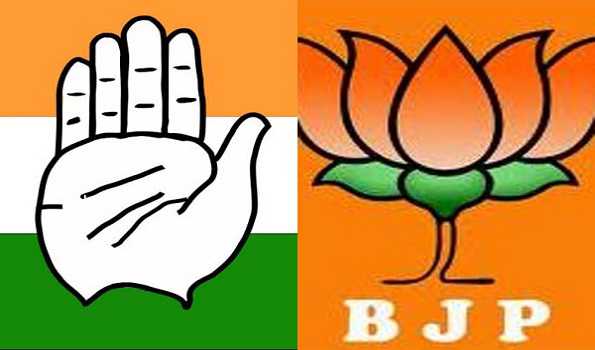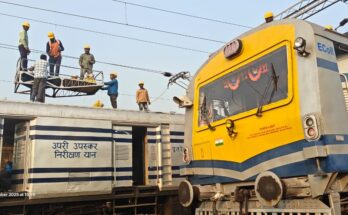By Rajesh Ahuja
The massive wave for change in the 2014 Lok Sabha elections saw the BJP ride to power at the Centre by decimating the Congress to a record low of 44 and marginalising the regional players like the Samajwadi Party, the Bahujan Samaj Party, the Indian National Lok Dal, the Janata Dal (United) and the Rashtriya Lok Dal.
The 2019 Lok Sabha elections, however, witness a changed political dynamics with a resurgent Congress post the win in the Hindi heartland states of Madhya Pradesh, Rajasthan and Chhattisgarh and a baggage of anti-incumbency faced by the NDA Government having taken away much of the sheen from the so-called ‘Modi wave’ that swept the country in 2014.
In the absence of a clear ‘wave’ in its favour, the BJP, sensing a marginal to significant drop in its seats in states like Uttar Pradesh, Rajasthan, Uttarakhand, Himachal Pradesh, Bihar, Jharkhand and Karnataka and perhaps even in Gujarat, would be looking to make inroads in Kerala, West Bengal and Odisha, invariably at the cost of regional parties like the Left, All India Trinamool Congress and the Biju Janata Dal.
Political observers say that an electoral push for the BJP in West Bengal, Odisha and Kerala is a prerequisite for the saffron party to keep alive its hopes to cross the majority mark in the Lok Sabha, more so since the Congress, post its victory in the Hindi heartland states of Rajasthan, Madhya Pradesh and Chhattisgarh, is hoping to increase it tally in several states.
Sources in the Congress party feel that the grand old party could see a significant increase in its tally in the states of Uttar Pradesh, Madhya Pradesh, Rajasthan, Chhattisgarh, Bihar, Jharkhand, Himachal Pradesh, Punjab, Assam and Haryana in the Lok Sabha elections.
Party sources feel that post the appointment of Priyanka Gandhi Vadra as the AICC general secretary incharge for Uttar Pradesh East and her campaign meeting in various parts of the state has generated a buzz among the party workers in the state over the prospects of the party in UP. Party leaders feel that the Congress, which managed to win just two seats in 2014 Lok Sabha elections, would increase its tally significantly.
Also, post its victories in the Assembly elections in Rajasthan, Madhya Pradesh and Chhattisgarh, the party hopes for a rise in its number of seats in these states this time. In the 2014 Lok Sabha elections, Congress won just one seat in Chhattisgarh, two in Madhya Pradesh while it failed to open its account in Rajasthan.
In Bihar, Jharkhand, Assam, Himachal Pradesh, Jammu and Kashmir and Punjab too, the party is hopeful of increasing its tally.
The party won three seats in Assam, one seat in Haryana and failed to open its account in Himachal Pradesh and Jammu and Kashmir in the 2014 Lok Sabha elections. In Punjab, it won only three seats in the 2014 Lok Sabha elections.
Similarly, in Karnataka, where the party managed to successfully forge an alliance with the Janata Dal (Secular) to form a government in the state, the Congress is confident about increasing its number of Lok Sabha seats from the tally of nine seats in the 2014 Lok Sabha elections.
The All India Trinamool Congress won 33 Lok Sabha seats in the 2014 Lok Sabha polls while the BID won 18 seats out of 21 Lok Sabha seats in Odisha.
In Kerala and Tripura , the CPI (m) won 9 Lok Sabha seats.
On their part, the BJP leaders express confidence of making inroads in West Bengal and Odisha. That the BJP is confident of increase its support in west Bengal and Odisha was stated by senior party leader and Finance Minister Arun Jaitley in a blog on Saturday.
‘The BJP, which was a party of the North, expanded to Central and Western India, and has now captured a large part of the political space in the East. To that extent, it has already consumed some of the space which was occupied by the regional parties of Bengal, Odisha, Assam and North-East, Jaitley wrote in the blog.
In fact, in his blog on Saturday, Finance Minister Arun Jaitley said that the BJP had a greater ability to fill the space occupied by the regional parties.
In such a situation, will the BJP’s road to victory in the 2019 Lok Sabha elections be at the cost of marginalisation of the regional players like All India Trinamool Congress, the BID and the Left?
‘That the BJP has the ability to fight and occupy more political space from the regional parties is already visible. The Congress inherently lacks that instinct,’he said.
That the BJP is looking to make inroads in West Bengal and Odisha in these polls is evident from a series of rallies and public meeting held over the past few months by Prime Minister Narendra Modi and the BJP president Amit Shah in West Bengal and Odisha, perhaps in a bid to increase the party’s public outreach in these states.
In fact, in their public rallies across the country, Prime Minister Narendra Modi and BJP president Amit Shah have expressed confidence that in the coming Lok Sabha elections, Odisha would see a surge in support for the BJP and that the state could turn the BJP way just as Tripura overwhelmingly voted in favour of the saffron party in the 2017 assembly elections in the state.
Further, BJP leaders have been claiming that there is a groundswell of support for the BJP in West Bengal this time with some even predicting eight to ten Lok Sabha seats for the party in the coming Lok Sabha elections.
Another state where the BJP would be looking to make inroads is Kerala.
In hus blog on Saturday, Jaitley expressed confidence that the coming Lok Sabha elections will witness the BJP make a mark in Kerala.
‘This election will witness BJP as a co-equal in Kerala. The unprecedented turnout at the Prime Minister’s Thiruvananthapuram rally on the 18th of April, would leave many scratching their heads for a reanalysis,’ Mr Jaitley said.
The 2014 Lok Sabha elections also saw the BJP occupy the political space held earlier by regional parties like the Samajwadi Party, the Bahujan Samaj Party and the Rashtriya Lok Dal in Uttar Pradesh and that occupied by the Rashtriya Janata Dal and the Janata Dal (United) in Bihar.
Jaitley, in his blog predicted a bleak future for caste based parties like the INLD, the BSP and the SP.
‘The changing socio-economic profile of India is no longer conducive to caste based parties perpetuating indefinitely. The sun will slowly but surely come down on that era,’ he said.
Notwithstanding the confidence exuded by the BJP of making inroads in west Bengal, Odisha and Kerala, the All India Trinamool Congress, the Biju Janata Dal and the CPM are confident of retaining their hold in their respective political space in these states.
While in West Bengal, The All India Trinamool Congress hopes to retain its tally of the 2014 Lok Sabha elections riding on the anger against the NDA Government over its unfulfilled promises and over the citizenship bill, in Odisha, the BJD is confident of retaining its hold riding on the good governance of the Naveen Patnaik Government.
Amid the confident posturing from the BJP and the All India Trinamool Congress and the Biju Janata Dal, it remains to be seen if the saffron party manages to accomplish its task of occupying the political space in west Bengal and Odisha held by the two regional parties.
While polling for 42 lok Sabha seats of West Bengal is being held in seven phases, polling for 21 seats in Odisha and the state Assembly is being held in four phases on April 11, April 18, April 23, and April 29.




